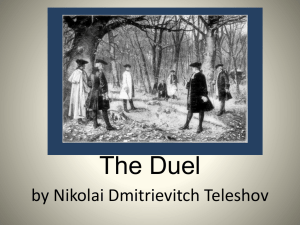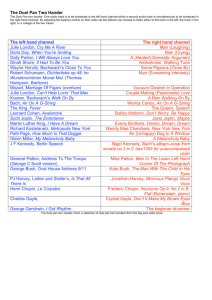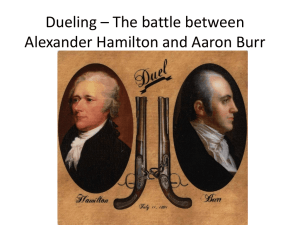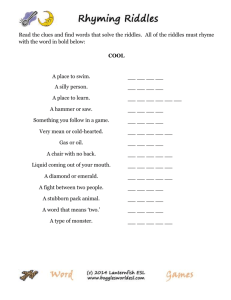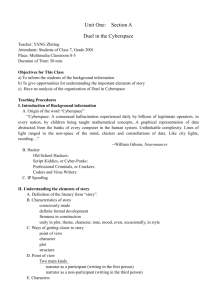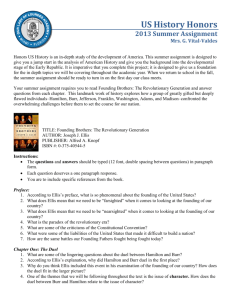color test color test color test color test
advertisement
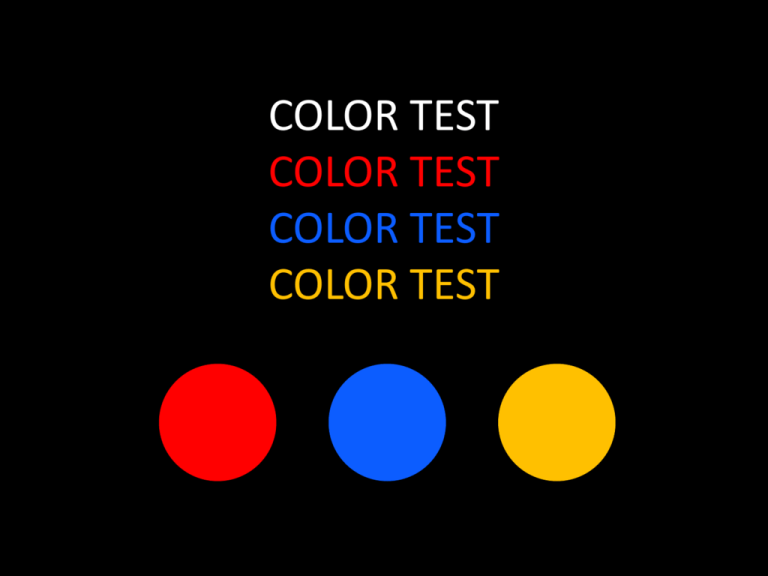
COLOR TEST
COLOR TEST
COLOR TEST
COLOR TEST
Dueling Algorithms
NICOLE IMMORLICA, NORTHWESTERN UNIVERSITY
WITH A. TAUMAN KALAI, B. LUCIER, A. MOITRA,
A. POSTLEWAITE, AND M. TENNENHOLTZ
Social Contexts
Normal-form games:
Players choose strategies to maximize
expected von Neumann-Morgenstern utility.
Social context games [AKT’08]:
Players choose strategies to achieve particular
social status among peers.
Social Contexts
Ranking games [BFHS’08]:
Players choose strategies to achieve particular
payoff rank among peers.
Two-Player Ranking Games
Bob
Alice and Bob play game:
Alice
G
1 Alice beats Bob in G
RG payoff of Alice:
½ Alice ties Bob in G
0 Alice loses to Bob in G
Implicit Representations
Succinct games [FIKU’08]:
Payoff matrix represented by boolean circuit.
NE hard to solve or approximate.
Blotto games [B’21, GW’50, R’06, H’08]:
Distribute armies to battlefields.
Implicit Representations
Optimization duels [this work]:
Underlying game is optimization problem.
Goal is to optimize better than opponent.
Ranking Duel
A search engine is an algorithm that inputs
• set Ω = {1, 2, …, n} of items
• probabilities p1 + … + pn = 1 of each
and outputs a permutation π of Ω.
Monopolist objective: minimize Ei~p[π(i)].
Ranking Duel
Competitive objective: Let the expected score of
a ranking π versus a ranking π’ be
Pri~p[ π(i) < π’(i) ] + (½) Pri~p[ π(i) = π’(i) ].
Then objective is to output a π that maximizes
expected score given algorithm of opponent.
Optimizing a Search Engine
User searches for object
drawn according to
known probability dist.
0.19
0.16
0.27
0.07
Search:
0.22
pretty shape
1.
(27%)
2.
(22%)
3.
(19%)
4.
(16%)
5.
(09%)
6.
(07%)
0.09
Choosing a Search Engine
1. Search for “pretty shape”.
2. See which search engine ranks
my favorite shape higher.
3. Thereafter, use that one.
0.19
0.16
Search:
0.27
pretty shape
0.07
Search:
0.22
0.09
pretty shape
1.
(22%)
1.
(27%)
2.
(19%)
2.
(22%)
3.
(16%)
3.
(19%)
4.
(09%)
4.
(16%)
5.
(07%)
5.
(09%)
6.
(27%)
6.
(07%)
Questions
Can we efficiently compute an equilibrium of a
ranking duel?
How poorly does greedy perform in a
competitive setting?
What consequences does the duel have for
the searcher?
Optimization Problems as Duels
Ranking
Binary Search
Routing
Finish
?
?
?
?
Start
Hiring
Compression
?
?
Parking
?
Duel Framework
Finite feasible set X of strategies.
Prob. distribution p over states of nature Ω.
Objective cost c: Ω × X
R.
Monopolist: choose x to minimize Eω~p[cω(x)].
Duel Framework
1 if cω(x) < cω(x’)
v(x,x’) = Eω~p
0 if cω(x) > cω(x’)
½ if cω(x) = cω(x’)
1. Players select strategies x, x’ from X.
2. Nature selects state ω from Ω according to p.
3. Payoffs v(x,x’), (1-v(x,x’)) are realized.
Results: Computation
An LP-based technique to compute exact
equilibria,
A low-regret learning technique to compute
approximate equilibria,
… and a demonstration of these
techniques in our sample settings
Computing Exact Equilibria
Formulate game as bilinear duel:
1.
2.
3.
4.
Efficiently map strategies to points X in Rn.
Define constraints describing K=convex-hull(X).
Define payoff matrix M that computes values.
Maps points in K back to strategies in original
setting.
Bilinear Duels
If feasible strategies X are points in Rn, and
payoff v(x, x’) is xtMx’ for some M in Rnxn, then
maxv,x v s.t.
xtMx’ ≥ v for all x’ in X
x is in K (=convex-hull(X))
Exponential, but equivalent poly-sized LP.
Ranking Duel
Formulate game as bilinear duel:
1. Efficiently map strategies to points X in Rn.
X = set of permutation matrices
(entry xij indicates item i placed in position j)
2. Define constraints describing K=convex-hull(X).
K = set of doubly stochastic matrices
(entry yij = prob. item i placed in position j)
Ranking Duel
Formulate game as bilinear duel:
4. Design “rounding alg.” that maps points in K back
to strategies in original setting.
Birkhoff–von Neumann Theorem: Can efficiently
construct permutation basis for doubly stochastic
matrix (e.g., via matching).
Ranking Duel
Formulate game as bilinear duel:
3. Define payoff matrix M that computes values.
Ep,y,y’[v(x,x’)]
= ∑i p(i) ( ½ Pry,y’ [x i = x’i ] + Pry,y’ [x i > x’i ])
= ∑i p(i) (∑i yij ( ½ y’ij + ∑k>j y’ik ))
which is bilinear in y,y’ and so can be written ytMy’.
Ranking Duel
Result: Can reduce computation time to poly(n)
versus poly(n!) with standard LP approach.
Technique also applies to hiring duel and
binary search duel.
Compression Duel
data
(each with prob. p(.))
Goal: smaller compression (i.e., lower depth in tree).
Classical Algorithm
:
Repeatedly pair nodes with lowest
probability.
Compression Duel
Formulate game as bilinear duel:
1. Efficiently map strategies to points X in Rn.
X = subset of zero-one matrices*
(entry xij indicates item i placed at depth j)
2. Define constraints describing K=convex-hull(X).
K = subset of row-stochastic matrices*
(entry yij = prob. item i placed at depth j)
* Must correspond to depth profile of some binary tree!
Compression Duel
Formulate game as bilinear duel:
3. Define payoff matrix M that computes values.
Ep,y,y’[v(x,x’)] = ∑i p(i) (∑i yij ( ½ y’ij + ∑k>j y’ik ))
which is bilinear in y,y’ and so can be written ytMy’.
Compression Duel
Bilinear Form:
maxv,x v s.t.
xtMx’ ≥ v for all x’ in X
x is in K (=convex-hull(X))
Problems:
1. How to round points in K back to a random
binary tree with right depth profile?
2. How to succinctly express constraints
describing K?
Approximate Minimax
Defn. For any ε > 0, an approximate minimax
strategy guarantees payoff not worse than
best possible value minus ε.
Defn. For any ε > 0, an approximate best
response has payoff not worse than payoff of
best response minus ε.
Best-Response Oracle
Idea. Use approximate best-response oracle to
get approximate minimax strategies.
1. Low-regret learning: if x1,…,xT and x’1,…,x’T
have low regret, then ave. is approx minimax.
2. Follow expected leader: on round t+1, play
best-response to x1,…,xt to get low-regret.
Compression Best-Response
Multiple-choice Knapsack:
Given lists of items with values
and weights, pick one from
each list with max total value
and total weight at most one.
Compression Best-Response
Depth:
1
2
3
4
Compression Best-Response
(each with prob. p(.))
x’ in K
For j from 1..n, list of depth j:
v( ) = Pr[win at depth j | x’ ]
w( ) = 2-j
… Kraft inequality
Other Duels
1. Hiring duel: constraints defining Euclidean
subspace correspond to hiring probabilities.
2. Binary search duel: similar to hiring duel, but
constraints defining Euclidean subspace more
complex (must correspond to search trees).
3. Racing duel: seems computationally hard,
even though single-player problem easy.
Conclusion
• Every optimization problem has a duel.
• Classic solutions (and all deterministic
algorithms) can usually be badly beaten.
• Duel can be easier or harder to solve, and can
lead to inefficiencies.
OPEN QUESTION: effect of duel on the solution
to the optimization problem?
